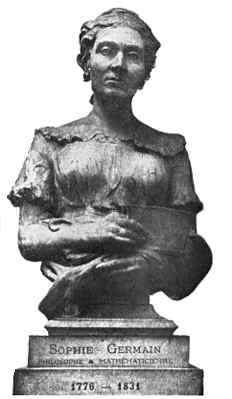

What do Archimedes, Monsieur LeBlanc, Lagrange, Gauss, and Fermat have in common? What -- or more precisely, who -- is the common factor for all these names is Sophie Germain, a French mathematician of the late 18th and early 19th centuries.
Archimedes: When Sophie was 13, she read about the legend of Archimedes' death: how he was so absorbed in the geometric figure he was drawing in the sand that he ignored the Roman soldier asking him a question and was thus speared to death. This story piqued Sophie's curiosity: to be so involved in a problem that you would die for it -- mathematics must be an interesting subject!
Monsieur LeBlanc: Because she was female, Sophie was not allowed to attend the Ecole Polytechnique in Paris. She was, however, able to study at the Ecole by assuming the identity of Antoine-August LeBlanc, a former student who had left Paris, an d getting his lecture notes and problems. In this way, Sophie was able to continue her mathematics education, even though she could not attend the lectures.
Lagrange: Joseph-Louis Lagrange was the supervisor of the course in which Sophie was secretly participating. Lagrange was so impressed by the turn-around of "Monsieur LaBlanc," a student originally of only mediocre skills, that he wanted to meet LaBlanc. Sophie was forced to reveal her identity, but Lagrange was impressed by this young woman and became her mentor and friend.
Gauss: Using her LaBlanc identity, Sophie began corresponding with Carl Gauss in 1804. She was intrigued by his work in number theory and sent him some of her work on the same subject. They corresponded for several years before Gauss discovered the true identity of his friend. In 1806, as war was surrounding Germany, Sophie, fearing Gauss would suffer the same fate as Archimedes, asked a friend of hers, who happened to be a general, to guarantee Gauss's safety. Gauss wanted to thank the person r esponsible for his safety, but was perplexed at who Mademoiselle Germain was, until Sophie explained that she had been LaBlanc.
Fermat: Fermat's last theorem -- one of the greatest challenges in mathematics -- was tackled by Sophie. Indeed, this work is her greatest contribution to mathematics. It is through this work that we have a special group of prime numbers known a s Germain primes. Germain primes are those prime numbers p such that 2p +1 is also a prime number. For example, 5 is a Germain prime because 2*5+1=11, which is also a prime number, but 7 is not a prime because 15 (2*7+1) is not a prime numbe r.
For more information on this very interesting woman of mathematics, check out the PBS page, Math's Hidden Woman, and Amanda Swift's Sophie Germain page.